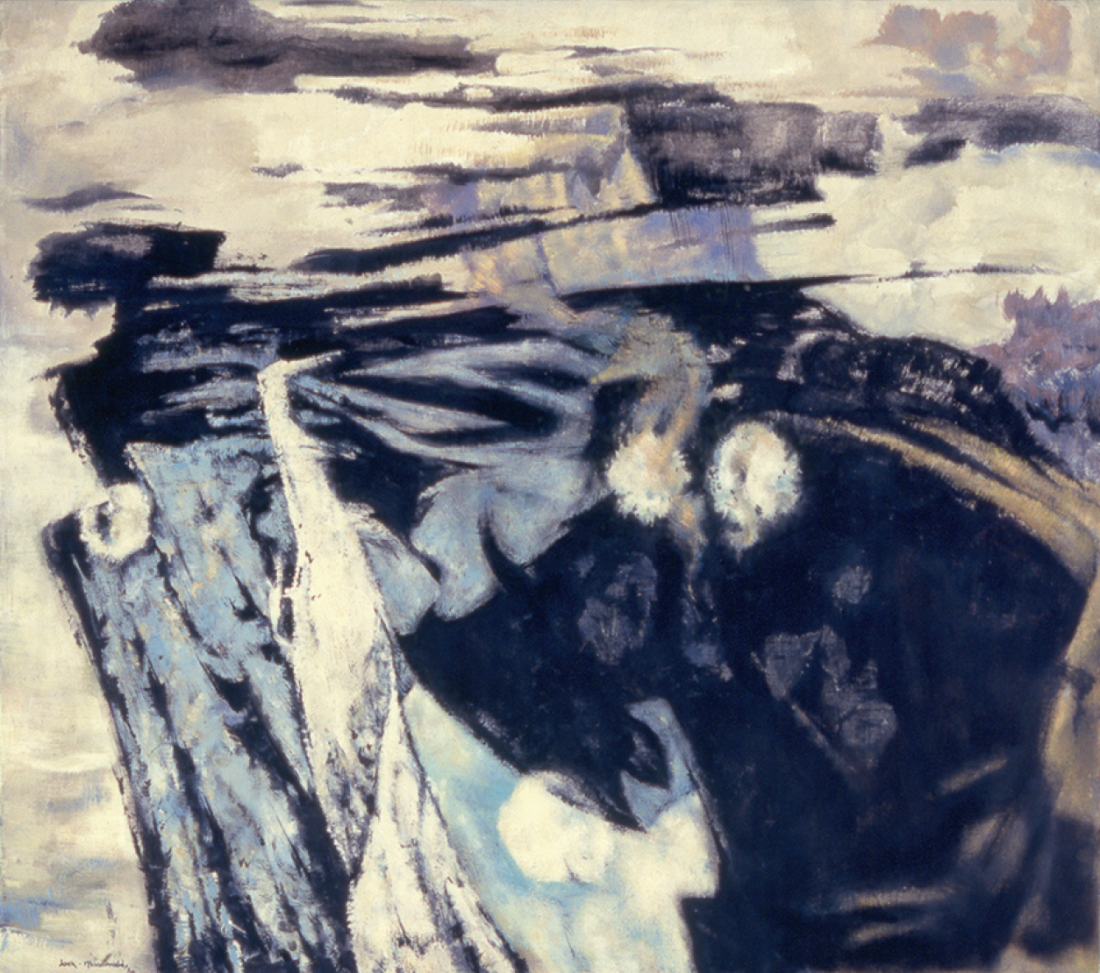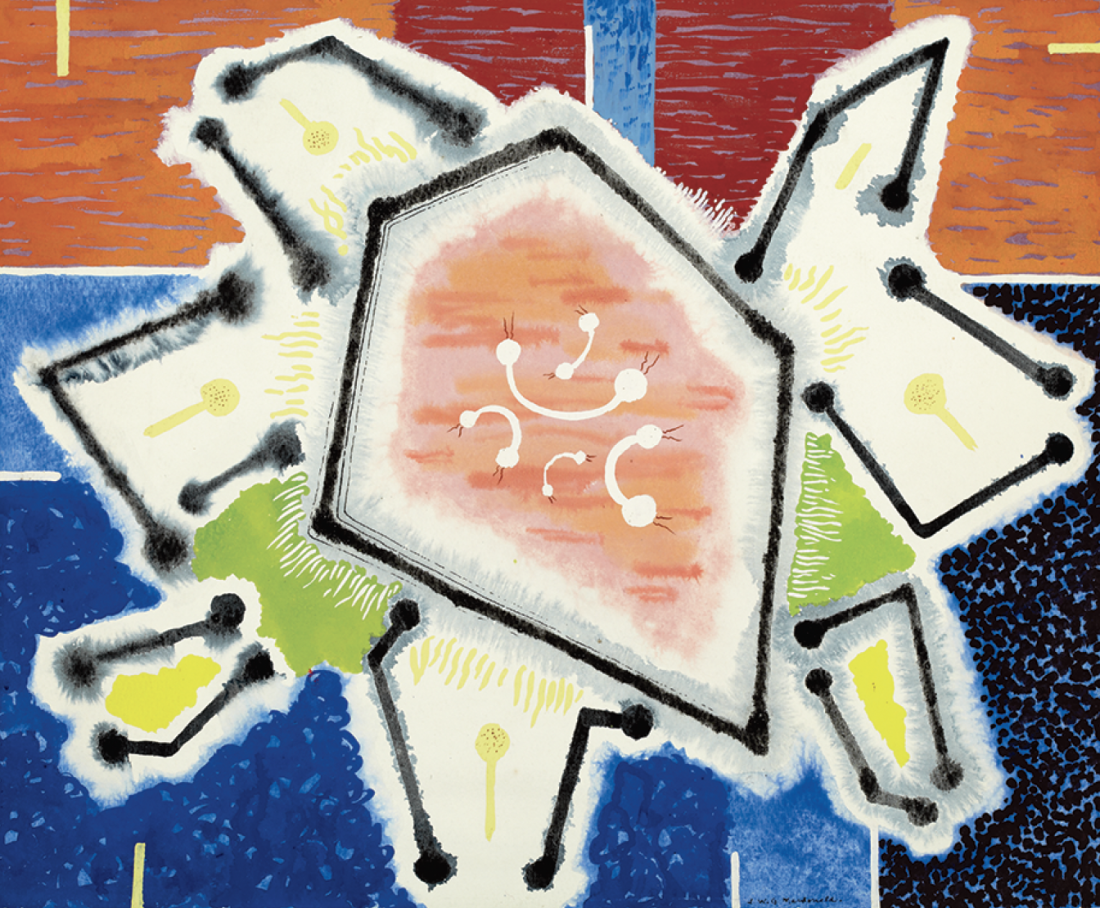Jock Macdonald
It has been almost 35 years since the distinguished artist-educator, Jock Macdonald (1897–1960), a leading member of Toronto’s Painters Eleven, was afforded a major retrospective. The touring exhibition, “Jock Macdonald: Evolving Form,” shown recently at The Robert McLaughlin Gallery, served as a reminder of Macdonald’s sustained search for an authentically personal mode of art-making. This particular selection of paintings ranged from the early, dynamically structured canvases of the British Columbia environment and simultaneous investigations into spiritually motivated, organic and geometric abstractions in the ’30s, to the mid-career automatic watercolours and evocative abstractions of the late ’50s through 1960.
Born and educated in Scotland, Macdonald received a design diploma from the Edinburgh College of Art as well as an art specialist teacher’s certificate from the Scottish Education Authority in 1922. He then worked as a textile designer and served briefly as head of design at the Lincoln School of Art. This initial interest in a career integrating studio exploration with a commitment to teaching continued when, in 1927, he was appointed head of design and instructor of commercial art at the Vancouver School of Decorative and Applied Arts. Macdonald immediately developed a close friendship with Frederick Varley, then head of painting and drawing.
Inspired by Varley’s example, Macdonald explored the unspoiled British Columbia landscape, initially in watercolour or tempera, and then with oil paint. These wilderness excursions challenged him to integrate his understandings of structural form with his acute perceptions of nature, into compositions of convincing authority. In a painting such as The Black Tusk, Garibaldi Park, 1932, he created a compelling aesthetic equivalent distilled from the observed movements, patterns, textures, and colour relationships in the environment that transcended literal representation. He also developed a curiosity about the relevance to the creative process of scientific theories, certain spiritual speculations, and emerging psychoanalytic thinking. The ideas of Rudolf Steiner, Rabindranath Tagore, PD Ouspensky and others greatly influenced his practice. As well, his admiration for the work of Lawren Harris, and their eventual friendship, helped give Macdonald the means by which the mysteries of existence might be evoked through art. By the mid-’30s, he was experimenting with metaphoric, nature-based abstractions, as in the explicit cosmic representations of Etheric Forms, 1934, and his geometrically organized ‘modalities’ such as the pastoral Spring Awakening, 1936.

Jock Macdonald, Elemental Fury, 1960, oil, Lucite 44 on canvas. Collection of the Montreal Museum of Fine Arts, Purchase, Horsley and Annie Townsend Bequest. Image courtesy Vancouver Art Gallery.
In 1944, Macdonald met Dr. Grace Pailthorpe, a British psychiatrist and Surrealist painter and Reuben Mednikoff, her artist partner, who introduced him to ‘automatic’ processes as a means to discover unpredictable imagery in the subconscious. As recounted in her catalogue essay, Linda Jansma recently found illuminating correspondence from Macdonald to Pailthorpe and Mednikoff, as well as a large number of his automatic works in the Scottish National Gallery of Modern Art.
From the mid-’40s onward, Macdonald employed this ‘automatic’ process in the creation of numerous works that vary from archetypical imagery to non-objective structures that resistexternal references and have their own internal order. During the summer of 1945, he taught for the first time at the Banff School of Fine Arts and introduced his outstanding student, Alexandra Luke, to the generative possibilities of Automatism. This initially pedagogical relationship with sustained exchanges led to a deeply valued friendship.
In order to secure a more congenial teaching opportunity and to increase his income, Macdonald accepted a faculty appointment to Calgary’s Institute of Technology for the 1946–47 academic year. In the fall of 1947, he joined the faculty of the Ontario College of Art in Toronto, where he hoped to focus more fully on his painting in a more stimulating cultural milieu. Unfortunately, most of the faculty at OCA admired neither Macdonald’s innovative approach to instruction nor his steadily developing abstractions. By contrast, his students regarded Macdonald as an inspiring, generous and knowledgeable teacher. As described by David Blackwood, “Jock Macdonald was an exceptional teacher and a great artist…He was totally capable of confronting realism and non-objective approaches to painting. He was a great believer in the evolution of the artist, sustained development and the maturing of individual vision, something not quite tolerated today….” Over his many decades as an exemplary teacher, Jock Macdonald influenced some of the country’s most important artists, including Alexandra Luke, William Ronald, Graham Coughtry, Richard Gorman, Garry Neill Kennedy, and many others. In turn, Luke and Ronald contributed in crucial ways to Macdonald’s ultimate achievements as a painter of significant abstractions. At Alexandra Luke’s urging, Macdonald briefly attended Hans Hofmann’s school in Provincetown, Massachusetts, during the summers of 1948 and 1949. Hofmann’s empathetic insights, which embraced both painterly spontaneity and intuition within an essential formal structure, reinforced Macdonald’s own evolving direction. In addition, William Ronald’s burgeoning success in New York brought Macdonald into significant, meaningful contact with the renowned, though controversial, critic Clement Greenberg.

Jock Macdonald, Nature’s Pattern, 1954. Collection of The Robert McLaughlin Gallery, Oshawa. Image courtesy The Robert McLaughlin Gallery.
Despite the lack of support by most of his OCA colleagues, Jock Macdonald was a widely respected artist whose paintings were increasingly included in significant solo and group exhibitions in Toronto, across Canada and in several US centres. By the early ’50s, his innovative abstractions began to be shown with artists of compatible inclinations, such as William Ronald, Jack Bush, Oscar Cahén, and others. By February, 1954, this empathetic association was formalized with the first Painters Eleven exhibition in Toronto’s Roberts Gallery. Even as Macdonald remained committed to the rigours of abstraction, he struggled to find an appropriate approach and medium that could match the vital immediacy of his ‘automatics’ in watercolour. Given limited studio space and income, he had difficulty working on a size and scale that matched his expressive ambitions, so he continued to produce accomplished works on paper such as Nature’s Pattern, 1954. Nevertheless, his relationships with the other members of the Painters Eleven challenged him to increase the physical and visual presence of his work. In 1957, when Harold Town introduced Macdonald to the quick-drying, fluid medium, Lucite 44, he found that when combined with oil paint, he could achieve the spontaneity and pictorial coherence he had long been seeking.
Despite great anxieties over his responsibilities at OCA, Macdonald’s practice flourished during this last period of his life. He created dozens of extraordinary abstractions from diverse sources that range in feeling from a sense of sublime grandeur to that of tender beauty. His death by heart attack on December 3, 1960, brought an untimely and tragic end to the promise of these inspired and ever-evolving late achievements. As evident in the haunting resonance of Rust of Antiquity, 1958, the dynamic tensions of Elementary Fury, the spatial and referential ambiguities of Far Off Drums, and the organic elegance of Nature Evolving (all three made in 1960), Jock Macdonald’s culminating interpretations of the forces and facts of nature remain satisfying intimations of aesthetic transcendence and human integrity. ❚
“Jock Macdonald: Evolving Form” is a travelling exhibit that was shown at the Robert McLaughlin Gallery, Oshawa, from February 3 to May 24, 2015. It opened at the Vancouver Art Gallery in October 2014 and will be at the Art Gallery of Greater Victoria from June 12 to September 7, 2015.
Ron Shuebrook is an artist, educator, writer, and cultural advocate living in Guelph, ON, and Blandford, NS.

